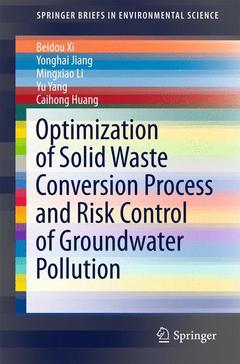Description
Optimization of Solid Waste Conversion Process and Risk Control of Groundwater Pollution, 1st ed. 2016
SpringerBriefs in Environmental Science Series
Authors: Xi Beidou, Jiang Yonghai, Li Mingxiao, Yang Yu, Huang Caihong
Language: English
Subjects for Optimization of Solid Waste Conversion Process and Risk...:
52.74 €
In Print (Delivery period: 15 days).
Add to cartSupport: Print on demand
Description
/li>Contents
/li>Biography
/li>Comment
/li>
This book focuses on the treatment and disposal technology used for solid waste in China, puts forward an optimal management scheme that takes into account the complete lifecycle, and introduces a new technical model that reflects the synergies of resource utilization and secondary pollution control. In addition, it provides a set of methods for professional on-site investigation, risk assessment, classification management and control to minimize the risk of groundwater contamination by solid waste at landfill. Given the extent and depth of knowledge and experience gathered in the book, it offers an important reference guide for government managers, environmental researchers, and all those involved in and concerned about solid waste disposal.
Professor Xi Beidou is 2013 The National Outstanding Youth in China, engaged in the field of environmental engineering more than 20 years. Now, he is the chief expert of Groundwater and Environmental Systems Engineering Innovation Base in Chinese Research Academy of Environmental Sciences (CRAES). CRAES is attached to the Ministry of Environmental Protection of China. The authors were familiar in the environmental policy and participated in writing strategic research and national development plan frequently. Aimed at solid waste resources and its effect on groundwater pollution, we take charge of 20 related projects. Based on the work we have done, over 200 papers have been published, 25 environmental patents were registered, and different kinds of scientific prizes were awarded.
Includes supplementary material: sn.pub/extras




